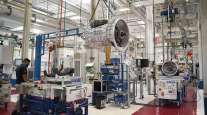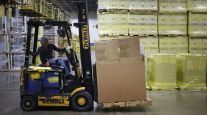Factories Expand as Orders Grow at Fastest Pace in Five Months

Manufacturing expanded more than forecast in May as orders grew at the fastest pace in five months, indicating the industry is starting to emerge from a first-quarter slump.
The Institute for Supply Management’s factory index rose to a three-month high of 52.8 from 51.5 in April, figures from the Tempe, Arizona-based group showed June 1. The median projection of economists in a Bloomberg News survey called for a reading of 52.
The pickup in bookings and the strongest reading for order backlogs since November point to production gains that probably will help the economy bounce back after shrinking last quarter. While two months of improved business investment and the end of a labor dispute at West Coast ports are allowing manufacturing to stabilize, progress may be halting as a strong dollar hampers export sales.
More investment spending would “certainly be a big positive because that’s been an area that’s been a consistent disappointment for the economy for quite some time,” Stephen Stanley, chief economist at Amherst Pierpont Securities in Stamford, Connecticut, said before the report. Temporary factors “are starting to wear off whereas the dollar’s impact is probably still pretty stiff at this point.”
Estimates in the Bloomberg survey of 84 economists ranged from 50 to 53. Readings greater than 50 indicate growth.
In Europe, manufacturing in Spain and Italy expanded more than forecast in May as the weaker euro helped drive exports. Markit Economics said its gauge for Italy climbed to 54.8, the highest level since 2011, while the Spanish measure jumped to 55.8. Markit’s factory PMI for the 19-nation euro region matched the strongest reading since May 2014.
The unchanged reading in purchases followed a 0.5% gain the prior month that was larger than previously estimated, U.S. Commerce Department figures showed.
The median forecast in a Bloomberg survey of 79 economists called for a 0.2% rise. Earnings increased 0.4%, more than projected, and the saving rate climbed.
ISM’s measure of new orders climbed to 55.8 in May from 53.5, while the gauge of order backlogs increased to 53.5 last month from 49.5.
More factories also said they were expanding headcounts, with ISM’s gauge of employment climbing to 51.7 in May from 48.3.
The measure of production eased to 54.5 from 56, while the export index cooled to 50 from 51.5.
A swelling trade gap in the first quarter subtracted the most from gross domestic product in 30 years as the appreciating dollar caused exports to slump. The deficit cut 1.9 percentage points from growth, the most since 1985.
GDP, the volume of all goods and services produced in the United States, shrank at a 0.7% annualized rate, revised from a previously reported 0.2% gain, according to Commerce Department figures issued May 29.
The economy is poised to pick up this quarter. A Bloomberg survey of 72 economists from May 8 to May 13 projected GDP will climb at a 2.7% pace in the April-through-June period, with household consumption expanding 3.2%.
Continued improvement in the labor market that includes bigger pay gains would help encourage more spending and propel growth.
“The U.S. economy seems well-positioned for continued growth,” Federal Reserve Chair Janet Yellen said in a May 22 speech in Providence, Rhode Island. If the economy continues to improve as she expects, “it will be appropriate at some point this year” to start raising rates, she said.
Recent figures showing pickup in the housing market helps explain why Deere & Co., the largest maker of farm equipment, forecast May 22 better-than-expected profit for fiscal 2015, The Moline, Illinois-based company said improvements in U.S. building activity spurred demand for its construction equipment.
While poor winter weather and shipping delays due to the port dispute earlier this year were temporary, the damage caused by the plunge in fuel prices and stronger dollar may be longer-lasting for manufacturers.
Oil’s recovery from a six-year low faltered in May as U.S. output remains at the highest level in more than three decades. OPEC’s refusal to cut production will continue to weigh on prices, according to Goldman Sachs Group Inc., Deutsche Bank AG and Citigroup Inc.




